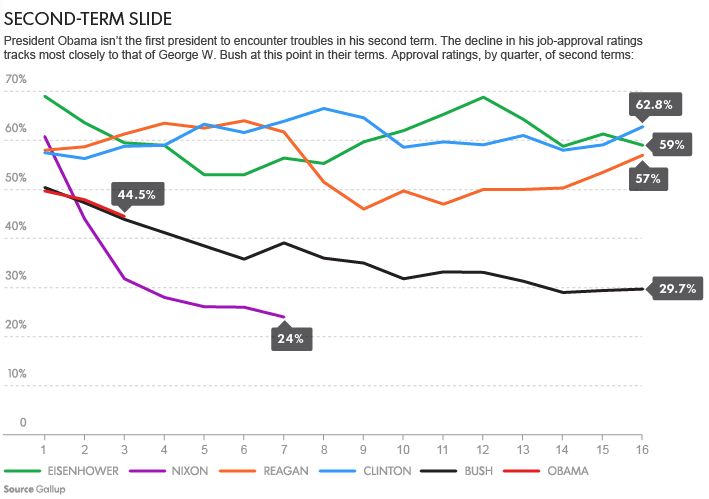Journalists rightly seek to tell compelling stories, which can bring abstract or dry topics to life, but the need to create a compelling narrative can be dangerous in politics. As we’ve seen in recent weeks, the focus on storytelling over analytical precision pulls the media toward overstated claims, false binary choices, and simplified narratives, especially when it comes to the presidency.
The most recent example is the current cycle of media overreaction to Barack Obama’s difficulties. First, troubles with the rollout of HealthCare.gov led to wild speculation that the law was doomed. When it became clear the Affordable Care Act won’t be repealed any time soon, pundits shifted to the argument that while the law itself might be salvaged, it was already “game over” for Obama’s presidency–and that, after a series of negative stories, “chances are he never recovers Americans’ trust”. (The New Republic’s Alec MacGillis has already tackled the flaws in these arguments.)
To support these hyper-pessimistic assessments, journalists point to the historical record, which suggests that second-term presidents struggle to regain their previous levels of popularity, and to the current resemblance between Obama’s current approval ratings and those of George W. Bush at this point in his term, which is illustrated by this graphic from USA Today:

The pattern of presidential difficulties during second terms is real, but journalists tempted to declare Obama’s presidency dead should recall the history of premature media postmortems. Remember what happened to Bill Clinton after the GOP landslide in the 1994 Congressional elections, only halfway through his first term? Pundits were suggesting he might already be “irrelevant” and even asking if he would be removed from the Democratic ticket in 1996. Likewise, we should not make too much of the current similarities in approval ratings between Obama and Bush. Obama is unlikely to enjoy the high second-term approval ratings of Bill Clinton, but we should be cautious about extrapolating from his recent troubles to a Bush-like second-term collapse in support.
This media doomsaying is just the first part of the media cycle, however. More recently, we’ve moved into the subsequent search for supposed turning points–the next step in the oscillation of overreaction that keeps cable news and the Sunday shows humming (“It’s all over!” “He’s back!”). NBC’s First Read wondered last week if Obama had “turned the corner” on the news cycle. At The Washington Post, Sean Sullivan wrote a post Wednesday arguing that while the president is damaged, “the worst may be behind Obama.” Sullivan at least offered two polls in support of his case and linked to some contrary evidence. At Talking Points Memo, Tom Kludt went even further, seizing on a single poll to assert that “Approval Of Obama, Obamacare Back To Pre-Rollout Levels.”
Survey results shouldn’t be covered piecemeal in search of evidence that Obama has “turned the corner.” Instead, journalists should consult poll aggregators such as Huffington Post Pollster (where I sometimes contribute), which find no clear evidence of improvements in Obama’s standing, as both The Washington Post‘s Jonathan Bernstein and HuffPost Pollster’s Mark Blumenthal and Ariel Edward-Levy correctly note. Blumenthal and Edwards-Levy conclude in their most recent update Wednesday that “perceptions of [Obama’s] job performance have worsened since October, but may have leveled off in November”–a far more judicious reading of the evidence. Just as it’s too soon to say Obama’s presidency is over or that he’s destined to follow Bush down in the polls, we don’t have sufficient data to say that his standing has rebounded either.
Stepping back, it’s remarkable how little we learn from this sort of coverage, which reflects the simplistic president-focused perspective that dominates the national media. We’ve made the president the lead character in an epic battle for political support and put that story at the center of our coverage of American politics. There’s more to the presidency than polls, however. As the Post‘s Ezra Klein noted Tuesday, Obama was unlikely to get additional major legislation through Congress regardless of his poll numbers, but he still has many other tools to advance his policy agenda–more than he did a few weeks ago, in fact, now that his judicial and executive branch nominees can’t be filibustered in the Senate. Unfortunately, producing compelling coverage that explains what’s actually happening in Washington is hard, while telling people what it supposedly means for Obama is all too easy.
Follow @USProjectCJR for more posts from this author and the rest of the United States Project team.
Brendan Nyhan is an assistant professor of government at Dartmouth College. He blogs at brendan-nyhan.com and tweets @BrendanNyhan.
